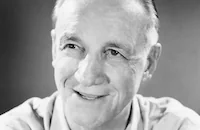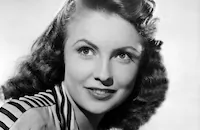Woman They Almost Lynched
Cast & Crew
Allan Dwan
John Lund
Brian Donlevy
Audrey Totter
Joan Leslie
Ben Cooper
Film Details
Technical Specs

Synopsis
During the Civil War, Border City, an Ozark mountain town laying on the Missouri-Arkansas border, is prone to wartime fervor because it divides the Union and the Confederacy. As no man has been courageous enough to bring law to the often violent town, Mayor Delilah Courtney has tried to minimize the violence by declaring the town neutral. Neither Confederate nor Union troops are allowed within five miles of town without her permission and anyone caught breaking the neutrality is promptly lynched. Travelling from Michigan to Border City, genteel Sally Maris plans to join her brother, saloon owner Bitteroot Bill. Her journey is interrupted by Quantrill's Raiders, the legendary gang who once rode in defense of the South, but now terrorize the country for their own purposes. William Clarke Quantrill's men kill the Union soldiers escorting Sally's stagecoach, and then accompany her to Border City, where Quantrill hopes to buy lead from a mine owned by Courtney. However, after refusing the sale, Courtney gives him twenty-four hours to leave town. At the saloon, Quantrill's wife Kate, a former saloon singer who was Bill's girl friend before Quantrill kidnapped her two years earlier, heartlessly taunts Bill. Still heartsick and jealous, Bill tries to shoot her, but Lance Horton, Courtney's mine foreman, intervenes and kills Bill. When Sally learns of Bill's death, she wants to sell the saloon, but Bill's gambling debts exceed the saloon's value. Unable to return to Michigan and finding no other job available, Sally takes on the management of the saloon with the help of the three dance hall girls, Glenda, Rose and Jenny, and the piano player, John Pablo. Later, when the spiteful Kate provokes the patriotic sentiments of men in the saloon, Sally stops them from killing each other by wrestling Kate. The crowd is placated by their fight, but after Sally drags the defeated Kate out of her saloon, young Jesse James, who is a member of Quantrill's gang and an admirer of Sally, warns her that Kate will plot revenge. Although Sally at first distrusts Lance for shooting Bill, she has learned that Bill changed after losing Kate, and offers Lance a partnership in her saloon to help her handle the rowdies. Although pleased with her change of heart, Lance tells her in confidence that he is really a Confederate spy and must flee town that evening as Quantrill has blackmailed him for lead from the mine. After Lance and Sally kiss, he tries to leave, but is abducted by Quantrill's men, who want to be taken to the mine in the morning. Meanwhile, Jesse warns Sally that Kate means to shoot her and lends her his guns. Early the next morning, Sally, whose Michigan training included handling a gun, meets Kate on the street, and in a shootout, disables Kate's gun hand. Because Quantrill has refused to leave town, Courtney has asked for help from the Union troops garrisoned nearby. When they arrive, shooting erupts and Sally brings Kate into the saloon for safety. Touched that Sally saved her life, Kate reveals that, after being kidnapped, she took her rage out on the world instead of on Quantrill, whom she hates. Cole Younger, one of Quantrill's men, who wants Sally, tries to carry her away during the shooting. Jesse and Lance save her, but Lance is shot. Finally, Quantrill's gang retreats from town, leaving Kate behind. Union officers show up at the saloon looking for Kate, who is wanted for Quantrill atrocities, and for Lance, who they have learned is a Confederate officer. Dressed up as a saloon girl, Kate, with the help of Sally's employees, sneaks Lance to a nearby Confederate camp. Meanwhile, Sally tricks Courtney and the Union soldiers into believing that she, not Lance, is the spy and is taken to the hanging tree to be lynched. Kate rides up just in time and tells the crowd the truth about Sally, then, after revealing her own identity, races away to the Confederate camp before the Union soldiers can catch her. Sally is released and resumes saloon operations, and after the war ends, Lance returns to town to marry her.

Director

Allan Dwan
Cast

John Lund

Brian Donlevy

Audrey Totter

Joan Leslie

Ben Cooper
Nina Varela

Jim Davis
Reed Hadley

Ann Savage
Virginia Christine
Marilyn Lindsey
Nacho Galindo

Ellen Corby
Minerva Urecal
Richard Simmons

Gordon Jones
James Brown

Frank Ferguson
Tom Mcdonough
Ted Ryan
Richard Crane
Carl Pitti
Joe Yrigoyen
Jimmie Hawkins

James Kirkwood
Paul Livermore
Fern Hall
Boyd Red Morgan
Post Park
Hal Baylor
Heenan Elliott
Robert Davis
Hank Patterson
Dick Alexander
George Chesebro
Tex Terry
Rush Williams
Lee Roberts
Andy Brennan
Crew
Fred Allen
Earl Crain Sr.
Allan Dwan
Steve Fisher
Peggy Gray
Reggie Lanning
Peggy Lee
Howard Lydecker
Theodore Lydecker
Bob Mark
John Mccarthy Jr.
George Milo
Sidney D. Mitchell
Adele Palmer
Robert Shannon
Sam H. Stept
James Sullivan
Howard Wilson
Stanley Wilson
Herbert J. Yates
Victor Young

Film Details
Technical Specs

Quotes
Trivia
Notes
The film was inspired by the life of William Clarke Quantrill. For more information about him, see the entry for Dark Command in the AFI Catalog of Feature Films, 1931-40. Some historical sources state that Quantrill kidnapped Kate King and forced her to be his mistress, as depicted in Woman They Almost Lynched. However, other sources claim that, in her later years, Kate told newspaper reporters that she was very much in love with Quantrill and eloped with him when she was thirteen. She reportedly married him in a church near her parents' farm on the Kansas and Missouri border.
Although the film, and some legends, depict Kate dressed in men's clothing, other sources claim she would have been safer dressed as a woman due to the the chivalrous nature of both Confederate and Union soldiers, and is unlikely to have dressed as a man or joined in the guerrilla warfare of her husband's men. She took Quantrill's middle name "Clarke" as her surname, and after his death, according to various sources, ran either a St. Louis bawdy house or boarding house, remarried twice, and eventually returned to the Kansas City area. She died there in 1930.
According to a May 1952 Hollywood Reporter news item, the film was originally planned to be shot in Trucolor. Portions of the film were shot on location at Idyllwild, CA. Although the viewed print indicates that the film was re-released, the re-release date has not been determined.












